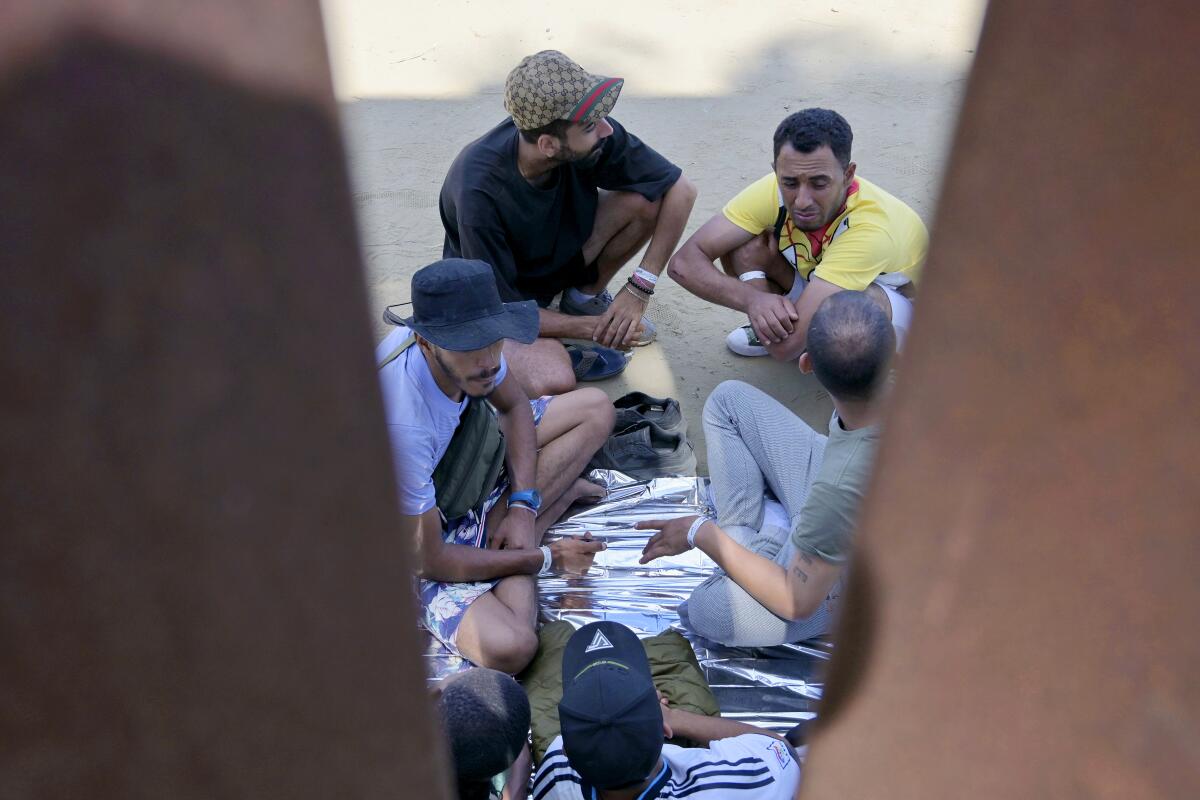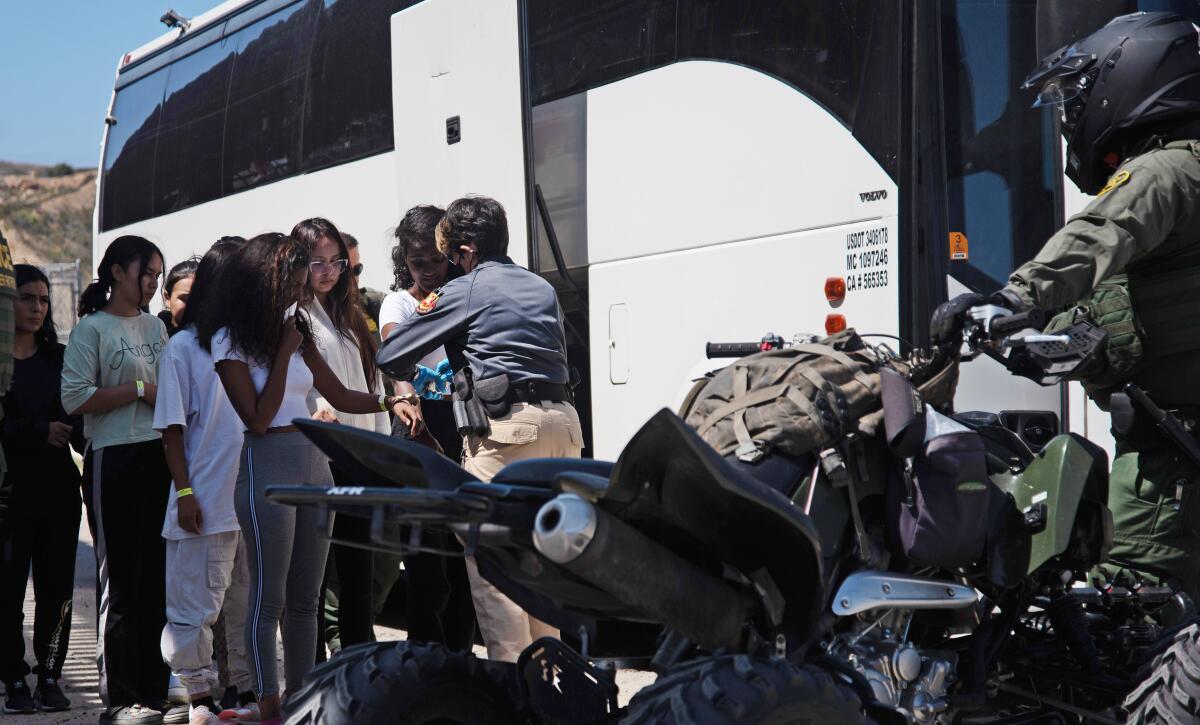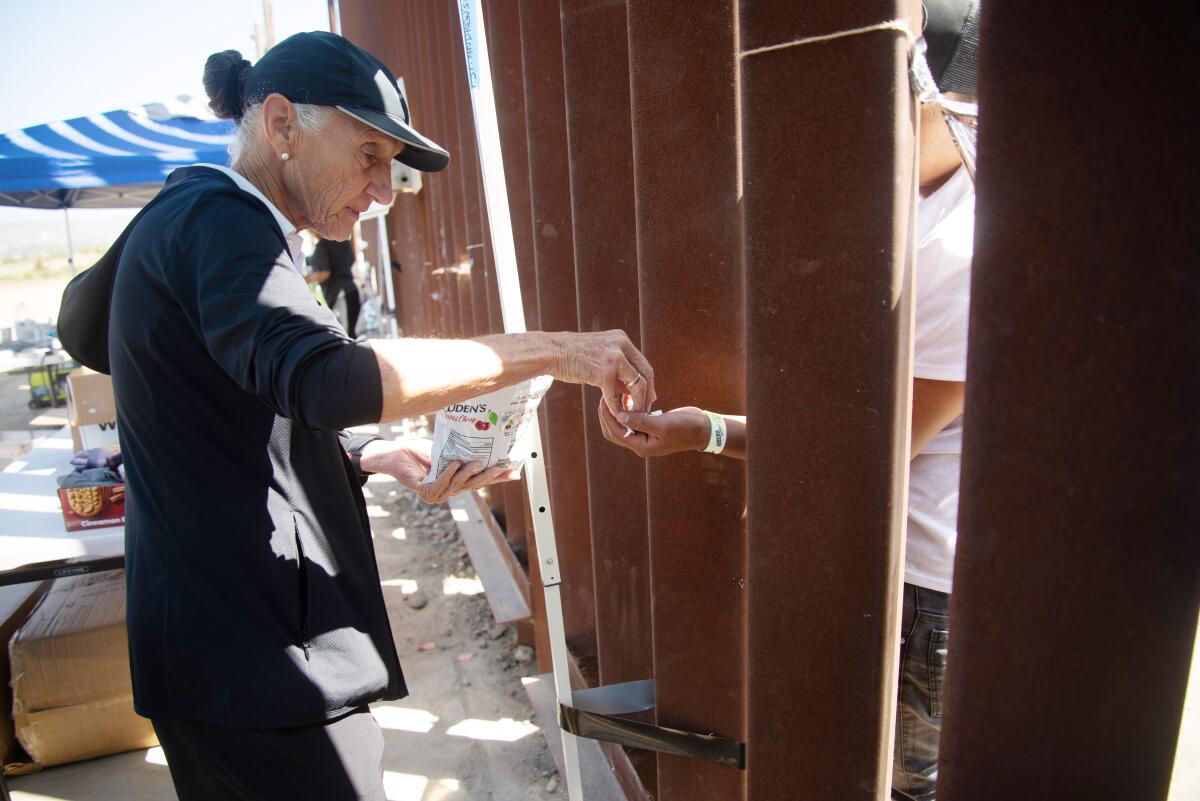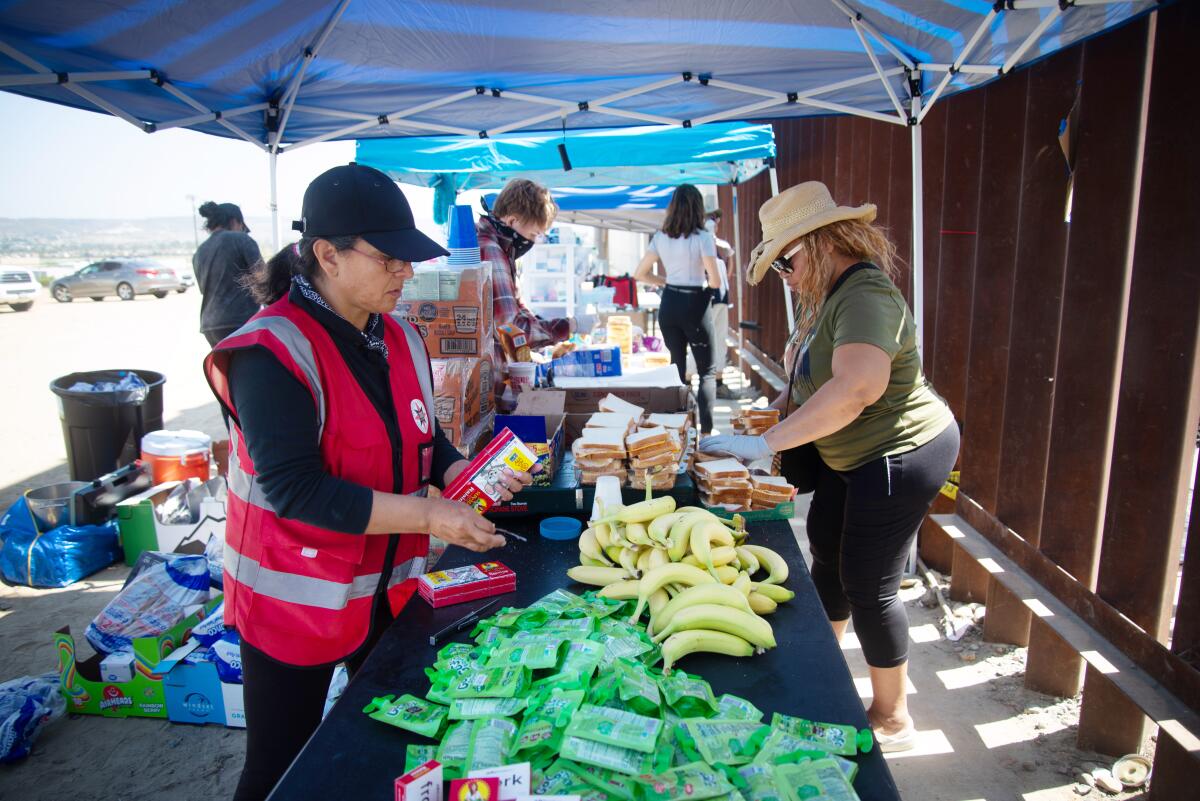Border Patrol leaves migrants stranded in San Diego as shelters reach capacity

SAN DIEGO — After the migrants stepped off a bus in San Diego, Border Patrol agents ushered them across the street to a parking lot, then left.
The migrants stood there, asking questions: When were the agents coming back? Hadn’t the agents promised them a hotel room for the night?
After arduous journeys from countries including Colombia, Peru, Brazil, Turkey, Cameroon, Guinea, Ghana and Burkina Faso, they were finally on U.S. soil, free to seek out friends and relatives around the country while their immigration cases were being adjudicated. But the joy they should have felt seemed absent, overtaken by their confusion about what to do next.
The Border Patrol agents had dropped them off with no explanation Wednesday around 6 p.m. by the Iris Avenue trolley station.
Most didn’t have working phones. Some tried to find Wi-Fi to contact loved ones about flights or hotels. Two men from Senegal briefly borrowed a hot spot from a bus driver.
Even if they managed to make travel arrangements, where would they sleep that night?
“Why did they leave us here so late in the day?” a Peruvian man asked in Spanish. He, like other migrants interviewed by The Times, asked not to be identified because of danger in their home countries and concerns about retaliation in their asylum cases.

With more Border Patrol buses expected to drop off migrants at San Diego trolley stops over the next few weeks and groups of migrants being held in open areas between border walls, the federal government is leaning into controversial tactics to lower the number of people held in Border Patrol stations along the U.S.-Mexico border.
Many migrants will probably be left to sleep outdoors, though volunteers are trying to help.
Customs and Border Protection, Border Patrol’s parent agency, said agents are following its “standard processes to quickly decompress the areas along the Southwest border and safely and efficiently screen and process migrants to place them in immigration enforcement proceedings consistent with our laws.”
In California, migrants typically receive short-term help, including food and hotel rooms, from shelters funded by the federal government and in some cases the state. Staff members arrange transportation for migrants to join friends or family in other cities.
But as a result of California’s budget deficit, a shelter run by Catholic Charities has had to scale back beds for migrants from 1,600 to 800, according to Vino Pajanor, the nonprofit’s CEO. Many, from shelter operators to state officials, point to the federal government as being ultimately responsible for paying for shelter services, rather than the state.
The other area shelter, which is run by the San Diego Rapid Response Network and usually receives asylum seekers processed through the port of entry, is full and only able to accept the most vulnerable.
“We’re hoping this is temporary,” Pajanor said. “We don’t want people on the streets.”
As conditions worsen in some countries in Central America, South America, Africa and elsewhere, people fleeing government violence, repression, criminal gangs or a lack of economic opportunity make dangerous treks across the hemisphere, through Mexico and north to the U.S. border.

Border crossings dropped in June after larger numbers of migrants arrived in the spring. Crossings increased in July and have reportedly continued to increase, though data are only available through July, when the Border Patrol apprehended more than 132,000 people and about 51,000 more came through ports of entry. The total is still a bit less than the same time a year ago, as well as when crossings peaked in December and again in the spring.
Only about 17% of migrants crossed the border in California in July, according to CBP data. With border areas in Texas and Arizona receiving much higher numbers of migrants, Border Patrol officials have been flying and busing new arrivals to San Diego for processing.
But federal funding for California shelters has not kept up with the demand, said Kate Clark, an attorney with Jewish Family Service who manages the San Diego Rapid Response Network shelter.
California officials have asked shelters to prioritize migrants including families with young children, those with medical conditions and members of the LGBTQ+ community.
Scott Murray, a spokesperson with the California Department of Social Services, said that the prioritization is necessary and urged the federal government to invest in “migrant sheltering operations as a critical component of border security infrastructure and welcoming people fleeing violence and persecution.”
In late December 2022, when winter storms forced flight cancellations and local shelters couldn’t move people out fast enough, the Border Patrol similarly chose to release people to San Diego trolley stations.
On Wednesday night at the parking lot near the trolley station, the migrants from the Border Patrol bus conversed in Spanish, French, Brazilian Portuguese, Turkish, Arabic and other languages. Many are seeking asylum, and Border Patrol officials have allowed them to stay in the country until judges hear their cases.
A pair of brothers had fled Cameroon. There, an intense conflict between French speakers, who run the government, and English speakers, who are an ethnic minority, has left many imprisoned and tortured or killed. Many human-rights monitors are concerned that what is happening in the country amounts to genocide.
Several other men in the parking lot had fled Guinea, where the U.S. State Department has reported that since a military coup in 2021, residents are subject to arbitrary killings and detention, political repression and government corruption, among other major human-rights violations.
One of the men from Guinea complained of the conditions he had experienced in U.S. immigration custody — several days locked in a cold room, unable to see the sun, bathe or brush his teeth. He hoped to make it to a family member in New York.
“It’s really difficult,” he said in French. “But it was our decision to come here. It’s our problem.”
Meanwhile, at the border wall, a woman from Nicaragua wept underneath a metallic sheet tied to the wall as she talked about escaping threats from the regime of President Daniel Ortega, which has increasingly repressed dissent in the country. Her son already fled to the United States last year. More recently, she said, the government came after her. Now, she hoped to join her son in the Midwest.
“It’s not fair that we can’t live just because we have a different political belief,” she said in Spanish.
A mechanical engineer from Colombia said he had crossed the border two nights ago and huddled with other migrants under a tarp tied to the border wall to shelter from the rain that fell through the early morning. He said he fled Colombia because of the increased violence from criminal groups there and would join a friend in Florida who was willing to help him get settled.
When asked about his dreams of the future, his answer was simple: “Really, initially, my life. To have my life safe. And from there, to work. I know it won’t be easy, but I’m good at what I do.”
Many of these asylum seekers may eventually be found ineligible because of a Biden administration rule introduced this year that seeks to punish those who did not cross with an appointment at a port of entry and who passed through another country between leaving their home and arriving in the U.S.
On Wednesday, hundreds of migrants were waiting in custody on U.S. soil between two rows of border wall behind a water treatment plant. Members of Congress from California, including Rep. Robert Garcia (D-Long Beach) and Rep. Juan Vargas (D-San Diego), opened an investigation into the practice after migrants were left between the walls for as long as a week this spring.
Most migrants on Wednesday said they had been waiting one to two days, though messages received by The Times since then from a man from Mali held between the walls indicate the waits are already growing longer.
An official familiar with the situation but not authorized to speak to the media said that the number of people between the walls is growing faster than agents can move them out. When agents began their shift on Tuesday night, about 430 people were waiting between the walls, officials said. The agents moved about 250 people to stations for processing but found that by the end of the shift, more than 600 people were between the walls.
As in the spring, Border Patrol agents provide some water and granola bars to the migrants, according to many who were waiting there.
CBP blamed smugglers and denied that the people there were in its custody. It noted that agents were processing families first.
“Our USBP agents leverage all available resources to apprehend, transport, screen, and process migrants as expeditiously and safely as possible,” the agency said through an unnamed spokesperson.

Jenn Budd, a former Border Patrol agent turned immigrant rights activist, said that the agency has the resources to process people so they’re not left waiting between the walls.
“This is unnecessary,” Budd said as she stood by the border wall on Wednesday. “They spend all their money on militarization and nothing on asylum and how to process people.”
Volunteers from the American Friends Service Committee and Friends of Friendship Park, among others, have set up stations next to the border wall. On Wednesday, they handed sandwiches and water bottles, as well as pieces of cardboard to sleep on, to the migrants stuck on the other side.
Everything they are handing out comes from private donations, according to Adriana Jasso of the American Friends Service Committee. She said they especially need more water and Gatorade.
That afternoon, agents moved several buses of migrants to Border Patrol stations for processing. Among them was a woman who was visibly in pain and held her hip as she walked. One agent told another that the woman said she had fallen.
As with the other migrants, the agents handcuffed the woman’s wrist to a fellow migrant and sent her onto the bus. She paused when she reached the steps and motioned for the other migrant to wait. Many of the migrants on the bus will likely be released to the trolley stations in the coming days.
On Wednesday night, volunteers led by Immigrant Defenders Law Center arrived at the Iris Avenue trolley station to help the migrants who had just been dropped off.
They offered Wi-Fi hot spots, sandwiches and rides to hotels or the airport. They also found a church where some could shower and sleep.
Some migrants said they found flights departing on Thursday and Friday to places including New York, Massachusetts and Ohio.
Their court dates are mostly next spring and summer. After that, a judge will determine whether they are eligible for asylum.
More to Read
Sign up for Essential California
The most important California stories and recommendations in your inbox every morning.
You may occasionally receive promotional content from the Los Angeles Times.










